Abstract
The aerial spraying of pesticides by plant protection unmanned aerial vehicles (UAV) is a process in which the spray droplet deposition on target sites occurs under the influence of the downwash wind field. The downwash wind field is the most important factor affecting droplet deposition distribution characteristics in an aerial spray. To understand the mechanism of the downwash wind field, spray tests were conducted at different flight heights by using a DJI UAV, and the downwash wind field in the three-dimensional direction (X-directional wind, Y-crosswind, and Z-vertical wind) was measured by using a wind speed measurement system for UAV. Combined with the droplet deposition of aerial spray, the distribution characteristics of the downwash wind field and the influence of the downwash wind field on droplet deposition were studied. The results showed that it had obvious differences in the distribution of the downwash wind field for UAV at different flight heights. As the flight height increases, the downwash wind field in X-direction and Z-direction showed a strong to weak trend, while the downwash wind field in Y-direction showed an opposite trend. In addition, it was found that the downwash wind field in Y-direction and Z-direction both have a significant influence on droplet deposition. With the increase of flight height, the change of the downwash wind field led to a gradual decrease in droplet deposition in the effective spray area, and droplets deposited more uniformly. For the DJI T16 plant protection UAV in this test, the optimal flight height was 2.0 m, and the downwash wind field had a better improvement effect on droplet deposition. Therefore, in order to make full use of the downwash wind field of UAV, the appropriate flight height should be selected to improve droplet deposition of liquid pesticide and achieve a better control effect for crop disease and pests when UAV is used for aerial spray operations in the field. This study revealed the influence mechanism of the downwash wind field on droplet deposition of aerial spray, and proposed appropriate operation parameters from the perspective of practical operation. It was expected to provide data support for improving the operation quality of aerial spraying and the formulation of field operation specifications.
1. Introduction
Chemical application is an important agricultural production method of controlling plant diseases, insect pests, and weeds. However, the extensive spray of pesticides that is currently common in China not only leads to low effective utilization of pesticides, but also forms a large number of residues of pesticides, which seriously pollutes the ecological environment and threatens food and life safety [1]. According to statistics, the use of pesticides per unit area in China is 2.5 times the world average, and the area of contaminated arable land reaches 1 × 107 hm2, which accounts for about 1/10 of the arable area [2]. In the current crop production process, traditional manual and semi-mechanical operations are still the main methods of plant protection in China, which not only have low efficiency and high labor intensity, but also cause low utilization of pesticides [3,4]. Therefore, although the use of pesticides improves the yield of crops, it also pollutes the food and environment, leading to a global food and environmental crisis.
In recent years, China’s agricultural aviation industry has developed rapidly; especially, the rapid development and application of plant protection UAV, which is one of the important components of the agricultural aviation industry, has attracted widespread attention [5,6]. As a new type of plant protection operation in China, the aerial spray technology of plant protection UAV has improved the shortcomings of traditional plant protection operations. Due to its high spraying efficiency, better atomization effect, and pesticide utilization, and solving the problem that ground machinery is difficult to use in the field during crop growth, plant protection UAV is gradually becoming the preferred method of plant protection operations [7,8,9]. The use of plant protection UAV to spray pesticides for the prevention and control of crop disease and pests has become a new feature in the development of plant protection machinery.
With the widespread application of plant protection UAV, research on its low-altitude and low-volume aerial pesticide application technology has gradually become a research hotspot, and a series of explorations have been performed by researchers on the quality of its operation and the effect of droplet deposition distribution [10,11,12,13]. Qiu et al. [14] studied the relationship between the spray deposition concentration, deposition uniformity of the CD-10 single-rotor UAV, and the flight altitude, flight speed, and the interaction between the two factors by using the two-factor and three-level test method, and established the corresponding relational model. Qin et al. [15] studied the effect of spraying parameters on the droplet deposition distribution in maize canopy by changing the operation height and spraying width of the N-3 single-rotor UAV. Chen et al. [16] studied the effect of different spray parameters on the droplet deposition distribution in rice canopy by using different flight parameters of an HY-B-10L single-rotor electric unmanned helicopter.
It can be seen that the studies on the aerial spraying technology of plant protection UAV were mainly focused on the influence of aerial spraying operation parameters on droplet deposition distribution, while the importance of the influence of the downwash wind field on droplet deposition distribution is ignored. In fact, the main factor that affects droplet deposition distribution of aerial spraying is the downwash wind field below the UAV rotor, which is made up of the wind field generated by the rotating rotor and the wind field of the external environment [17]. Some researchers have used computational fluid dynamics (CFD) to simulate the wind field below the UAV rotor to analyze the droplet deposition distribution [18,19,20,21]. However, due to the interference of the external environment, the wind field distribution under the simulated condition is quite different from that under the actual field condition. Researchers have paid attention to the downwash wind field since the early days from the application of rice-assisted pollination technology by using agricultural UAV. Zhou and Li et al. [22,23,24] collected the downwash wind field of a single-rotor helicopter and multi-rotor UAV in rice pollination operations, and selected the best operating parameters based on the pollen distribution, respectively. However, there are no relevant reports on the research and application of the downwash wind field of plant protection UAV in aerial spraying technology. It is necessary to consider the influence of the downwash wind field fundamentally in the study of the characteristics of droplet deposition and drift in aerial spray operation. Therefore, in this study, a plant protection UAV was used as the research object to conduct aerial spraying tests under four different flight heights, and the downwash wind field was measured by using a wireless wind speed sensor network measurement system for UAV. Combined with the droplet deposition of aerial spray, the distribution characteristics of the downwash wind field and the influence of the downwash wind field on droplet deposition were studied, and it was expected to provide data support for improving the quality of aerial spraying operation and the formulation of field operation specifications.
2. Materials and Methods
2.1. Materials and Equipment
The UAV used in this spray test was a DJI T16 six-rotor electric UAV for plant protection (Shenzhen DJI Technology Co., Ltd., Shenzhen, China), as shown in Figure 1. The spraying system of the UAV is composed of hydraulic nozzles, pressure pump, tank, etc. The number of nozzles is eight, and two nozzles are used as a group to be symmetrically distributed under the rotors on both sides of the fuselage. The UAV model has the functions of route planning and autonomous obstacle avoidance, which can complete aerial spraying operation autonomously, and its main performance indicators are shown in Table 1. The nozzle type selected in this test is Teejet XR11001VS. When the UAV is spraying, the four nozzles behind the fuselage are turned on for spraying. The maximum flow rate of the spraying system can reach 4.8 L/min, and the spraying flow rate can be adjusted by the handheld ground station. In addition, when the flight height is 1.5~3.0 m, the range of the effective spray width is 4.0~7.5 m.
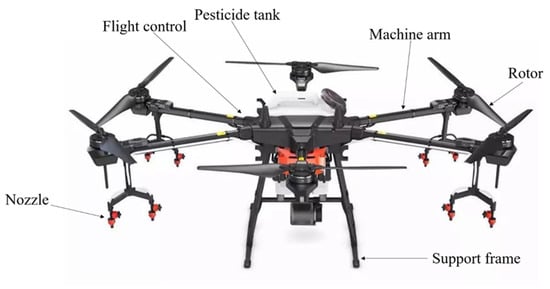
Figure 1.
DJI T16 six-rotor electric plant protection UAV.

Table 1.
Main performance index of UAV.
As shown in Figure 2, the wireless wind speed sensor network measurement system (WWSSNMS) for UAV (Guangzhou Fumin measurement and Control Technology Co., Ltd., Guangzhou, China) was used in this spray test, which includes impeller-type wind speed sensors (Figure 3) and wind speed sensor wireless measurement nodes. The impeller wind speed sensors measure the three-dimensional wind speed generated by the UAV flying. The measurement range of the system is 0~45 m/s, the measurement accuracy is ±3%, and the measurement resolution is 0.1 m/s. The wind speed sensor wireless measurement node is composed of a 490 MHz wireless data transmission module, a microcontroller, and a power supply module to realize the transmission of wind speed data to the Laptop. The working principle is shown in Figure 2. The single sampling time of the system is 5 s, the sampling frequency is 20 Hz, and the continuous working time of normal field work is 10 h.
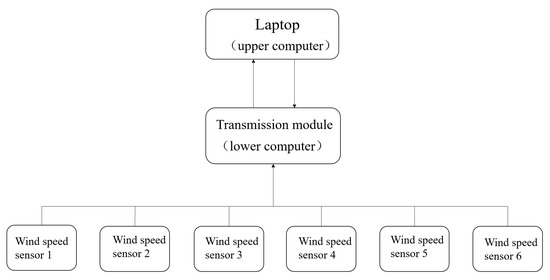
Figure 2.
WWSSNMS working principle.
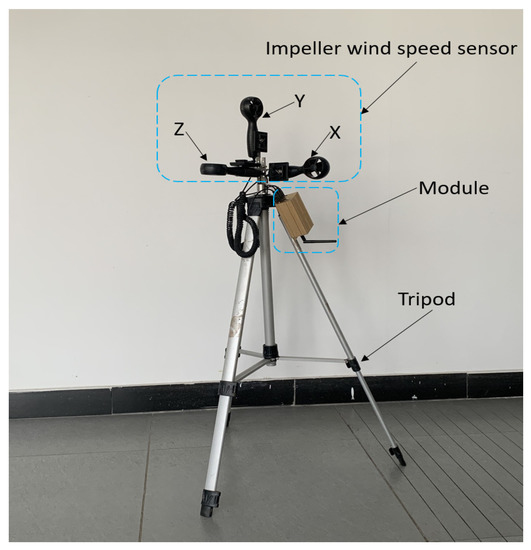
Figure 3.
Wind speed sensors.
2.2. Experiment Design
2.2.1. Test Site
The test site was the Wind Tunnel Laboratory of South China Agricultural University, Guangzhou City, Guangdong Province, China. A test site with a length and width of more than 120 × 30 m was selected, and the test site was covered with vegetation to simulate the actual field operation, where the height of vegetation was about 0.4 m (Figure 4). In addition, a surrounding wall with a height of 3 m was built around the site to block the external wind and eliminate the influence of external crosswind on the test.

Figure 4.
Test site.
2.2.2. Sampling Point Layout
The layout of droplet sampling points and wind field sampling points is shown in Figure 5.
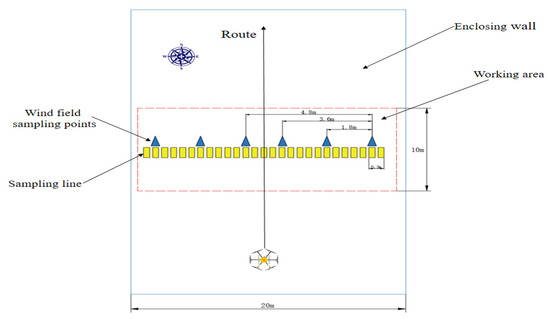
Figure 5.
Test plan.
The droplet sampling line perpendicular to the flight direction of the plant protection UAV was arranged in the center of the test site. The middle point was marked as 0 m, and 13 sampling points were arranged symmetrically on the left and right sides. The sampling points were all separated by 0.3 m, and these points were respectively recorded as −3.9, −3.6, −3.3, −3.0, −2.7, −2.4, −2.1, −1.8, −1.5, −1.2, −0.9, −0.6, and −0.3 m, and 0.3, 0.6, 0.9, 1.2, 1.5, 1.8, 2.1, 2.4, 2.7, 3.0, 3.3, 3.6, and 3.9 m. The total length of the droplet sampling line was close to 8 m, which is greater than the effective spray width provided in the UAV parameter index. These water-sensitive papers (WSPs, 26 × 76 mm, Syngenta Inc., Basel, Switzerland) were fixed horizontally on a tripod by using double-head clamps at each sampling point, and were used to measure the droplet deposition distribution. The height of these WSPs was about 0.6 m, which is close to the canopy height of the actual crop.
The wind field sampling line was parallel to the droplet sampling line and perpendicular to the UAV flight path. Six wind speed sampling points were symmetrically distributed along the UAV flight path. The measurement points were marked as −3.6, −2.1, −0.6, 0.6, 2.1, and 3.6 m from left to right. The field layout of the WWSSNMS nodes referred to the three-dimensional three-way linear gust wind field measurement method proposed by Hu et al. [25]. Each measurement node was equipped with three wind speed sensors to measure the direction parallel to the route (X-direction), horizontal and perpendicular to the route direction (Y-direction), and the wind speed perpendicular to the ground (Z-direction).
2.2.3. Test Plan Design
In this test, pure water was used to replace the chemical liquid for spraying. In order to eliminate the influence of wind field distribution caused by different load parameters on the test results, the volume of solution in the tank was the same before each test, which was 10 L. Four UAV flight altitudes of 1, 1.5, 2, and 2.5 m were set during the experiments. At least three valid repeat tests should be performed for each group. To ensure the authenticity and validity of test results, a normal flight speed of 5 m/s and a fully autonomous operation mode of plant protection UAV were selected for this spray test. During the test, the UAV was controlled to take off autonomously from 30 m outside the sampling area. After passing through the buffer area, the UAV was accelerated to the set speed and passed over the sampling line at a constant speed. The wind speed value started to be collected when the UAV was 5 m away from the wind field sampling line. The sampling duration was 5 s, and the acquisition frequency was 20 Hz.
2.3. Data Processing
Nearly 30 s after spraying, the sampling cards were collected and placed in properly labeled bags. The cards were scanned one by one by a scanner, and Deposit Scan software (US USDA) was used to obtain the coverage density, deposition, and droplet size at different locations after scanning [26]. The average value of droplet coverage density at each sampling location was used to represent the amounts of droplets per unit area, and the average value of droplet deposition at each sampling location was used to represent the deposition rate per unit area. In order to characterize the uniformity of droplet deposition between these sampling points, the coefficient of variation (CV) value was used to measure the uniformity of droplet deposition. The smaller the CV value, the better the uniformity of droplet deposition.
The downwash wind field data of plant protection UAV collected by the WWSSNMS at four different flight heights were imported into Origin 2018 software (Origin Lab., USA), and the wind speed distribution map was drawn. To further demonstrate the influence of the downwash wind field on the droplet deposition characteristics of aerial spray, the significant differences for the results of droplet deposition were conducted using analysis of variance (one-way ANOVA) by Duncan’s test at a significance level of 95% with SPSS v22.0 (SPSS Inc, an IBM Company, Chicago, IL, USA). More precisely, data are expressed as the mean ± standard deviation (SD).
3. Results and Discussion
3.1. Downwash Wind Field Distribution
The wind speed distribution map is shown in Figure 6, and can directly reflect the downwash wind field distribution at different flight heights. As shown in Figure 6a, the downwash wind field in Z-direction had two airflow centers at the acquisition position of ±0.7 m, which were symmetrically distributed along the center route when the flight height was 1.0 m. The distance between the centers of two airflows was about 1.5 m, which roughly corresponds to the distance between the centers of rotors on both sides of the UAV. The peak value of wind speed in the airflow center can reach 8.1 m/s, and the wind speed directly below the fuselage center was significantly lower than that on both sides. It also showed that the downwash wind field below the fuselage was concentrated in the coverage range (–1.5~1.0 m) directly below the rotor. The main downwash wind field in Y-direction was concentrated below the fuselage, and it was mainly distributed at the lower right of the fuselage with the peak wind speed of 4.2 m/s. This may be mainly due to the low flight height of UAV, resulting in insufficient space for the downwash wind field on both sides of the rotor to spread out fully. Different from the downwash wind field in Z-direction and Y-direction, the distribution of the downwash wind field in X-direction was relatively scattered, and did not form a large continuous airflow central area, but it covered a wider area. Moreover, there were some concentrated area of wind speed in X-direction at the collection positions of −2.0, −0.6, and 2.0 m, and the wind speed value was 3.8 m/s.
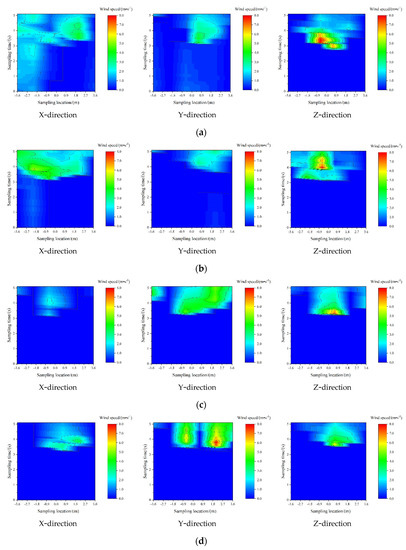
Figure 6.
Downwash wind field distribution at different flight heights. (a) Downwash wind field distribution at flight height of 1.0 m. (b) Downwash wind field distribution at flight height of 1.5 m. (c) Downwash wind field distribution at flight height of 2.0 m. (d) Downwash wind field distribution at flight height of 2.5 m.
As shown in Figure 6b, the downwash wind field distribution in Y-direction and Z-direction at a flight height of 1.5 m had no significant change compared with that of a flight height of 1.0 m. When the flight height was 1.0 m, the coverage of the wind field in X-direction became larger, and a large continuous airflow area was formed. As shown in Figure 6c, when the flight height reached 2.0 m, the airflow center of the wind field in Z-direction on both sides of the fuselage had disappeared and connected to form an airflow field with a wider central area. This phenomenon is mainly due to the gradual integration of the wind field in Z-direction on both sides of the fuselage into an air flow field under mutual disturbance with the increase of flight height. The distribution range of the wind field in Y-direction became larger, mainly −1.5~3.6 m, and two strong airflow areas gradually formed at −1 and 2 m on both sides of the central route with a peak wind speed of 5.0 m/s. As shown in Figure 6d, when the flight height was 2.5 m, the downwash wind field in X-direction and Z-direction was similar to the wind field distribution at a flight height of 2.0 m. However, as the flight height increased, the vertical downward flow field in Z-direction weakened with the peak wind speed of 5.8 m/s. The wind field in Y-direction spread to both sides of the fuselage, and obviously formed a distribution law of weak in the middle and strong on both sides, with the peak wind speed of 7.9 m/s. In plant protection operations, the distribution law of the wind field in Y-direction will make the sprayed droplets spread to both sides of the fuselage, which can increase the effective spray width of plant protection UAV to a certain extent, but it will also force the droplets to spread out of the target area, causing the droplets to drift horizontally.
From the above visual analysis of the wind field, it can be seen that the downwash wind field distribution of the UAV was obviously different at different flight heights. The downwash wind field in X-direction and Z-direction generally showed a trend of wind speed from strong to weak and a distribution range from large to small, while the downwash wind field in Y-direction showed an opposite trend. The wind field in X-direction was derived from the winding airflow generated by the interaction between the downwash airflow at different horizontal positions and the external ambient wind, which may increase the risk of droplet drift at the edge of the farmland plot for the spray operation on small-scale plots. Similarly, the wind field in Y-direction was the result of the downwash airflow spreading to both sides of the fuselage. The action direction of the wind field in Y-direction on droplets makes it move towards both sides of the route, which makes it easy to further aggravate the horizontal drift of droplets under crosswind conditions. In contrast, the wind field in Z-direction was the vertical downward component of the downwash airflow, which was generally considered to have a promoting effect on droplets’ deposition. Therefore, for spraying operations by using plant protection UAV, it is necessary to avoid the strong wind field in the horizontal direction while making full use of the wind field in the downward direction to improve the deposition rate of droplets and reduce the drift risk of pesticides.
3.2. Droplet Deposition Distribution Characteristics
Figure 7 shows the droplet deposition distribution in the spraying test of the plant protection UAV. According to previous studies [27], the flight height of the plant protection UAV would affect the effective spray width of droplet deposition. Therefore, in order to ensure the effectiveness of comparison and analysis on droplet deposition results, it is necessary to evaluate the effective spray width of the plant protection UAV in different spray tests [27]. According to the evaluation method of effective spray width with droplet density, the average effective spray width was 6.0, 6.9, 7.2, and 7.8 m at different flight heights.
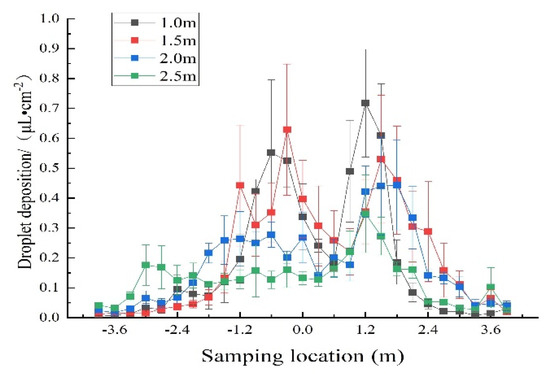
Figure 7.
Average droplet deposition rate at different flight heights.
The peak wind speed of the downwash wind field and droplet deposition distribution of the UAV at four different flight heights is shown in Table 2. It can be seen that the average droplet deposition in the effective spray width was 0.482, 0.436, 0.295, and 0.189 μL/cm2 respectively, at the four different flight heights. The results showed that the droplet deposition on the sampling line gradually decreased with the increase of flight height. It is worth noting that the average droplet deposition on the sampling line decreased sharply when the flight height increased from 2 to 2.5 m. Combined with the peak wind speed of the downwash wind field in Table 2, it can be seen that the main reason was that the downwash wind field in Z-direction gradually weakened with the increase of the flight height, resulting in the decrease of droplet deposition in the effective spray area. On the other hand, the gradual increase of the downwash wind field in Y-direction also made droplets drift more. In addition, it can be seen from the droplet deposition curve that there were two peaks of droplet deposition on both sides of the flight route, which was consistent with the distribution of the downwash wind field in Z-direction. The lower the flight height, the stronger the wind field in Z-direction on both sides of the flight route, and the more obvious the peak of the droplet deposition curve.

Table 2.
Distribution of the downwash wind field and droplet deposition.
Similarly, it can be seen that the CV of droplet deposition in the effective spray area were 58.3%, 62.0%, 48.6%, and 42.5% at altitudes of 1, 1.5, 2, and 2.5 m. The higher the flight height, the better the uniformity of droplet deposition. Combined with the analysis of the downwash wind field of UAV, it was mainly caused by the influence of the downwash wind field in Y-direction and Z-direction on droplet deposition distribution. When the flight height was low (1.0 and 1.5 m), the downwash wind field in Y-direction was weak, and the downwash wind field in Z-direction was strong and had two strong airflow central areas below the fuselage. The distribution of the downwash wind field was not conducive to the diffusion of droplets to both sides, so the droplet deposition under the airflow central area was significantly higher than that in other places, resulting in poor uniformity of droplet deposition. When the flight height of the UAV became higher (2.0 and 2.5 m), the downwash wind field in Y-direction was enhanced, while the downwash wind field in Z-direction was connected to form a whole airflow field. In this case, the distribution of the downwash wind field was more uniform, so the droplets were deposited more uniformly under the action of the wind field.
3.3. Analysis and Discussion
In order to further reveal the influence mechanism of the downwash wind field on droplet deposition distribution in the effective spray area, the peak wind speed in X, Y, and Z directions in each test was taken as the downwash wind field intensity to study the relationship between the downwash wind field and droplet deposition distribution. The peak values of wind speed in X, Y, and Z directions and droplet deposition distribution were analyzed by variance analysis and regression analysis respectively, and the analysis results are shown in Table 3.

Table 3.
Analysis of droplet deposition characteristics.
It can be seen that the p-values of the wind field in Y-direction and Z-direction on droplet deposition in the effective spray area were 0.041 and 0.001 respectively, which indicated that the wind field in Y-direction and Z-direction had a significant and an extremely significant influence on the droplet deposition, respectively. Moreover, according to the regression coefficient, the wind field in Y-direction and Z-direction had a negative and positive correlation with droplet deposition in the effective spray area respectively, indicating that the stronger the wind field in Z-direction and the weaker the wind field in Y-direction, the more droplet deposition in the effective spray area. For the uniformity of droplet deposition, the p-value of the wind field in Z-direction on the uniformity of droplet deposition in the effective spray area was 0.036, which indicated that the wind field in Z-direction had a significant influence on the uniformity of droplet deposition. Similarly, the wind field in Z-direction was positively correlated with the deposition uniformity. The stronger the wind field in Z-direction, the worse the uniformity of droplet deposition, which was consistent with the above results [17].
According to the analysis of the test results, the appropriate flight height should be set when UAV was used for aerial spraying in the field, not too high or too low. When the flight height is too high, the downwash wind field above the crop canopy will be weakened. The weakened wind field in the vertical direction would cause a sharp decrease in the amounts of droplets deposited on the crop canopy, and the increase of the horizontal wind field will aggravate droplet drift to the non-target area. When the flight height is too low, the strong downwash wind field in the vertical direction above the crop canopy will result in poor uniformity of droplet deposition, which cannot achieve the ideal control effect, such as the re-spray and missed spray [16,28]. Therefore, the downwash wind field in the vertical (Z) direction is regarded as the most important analysis factor affecting droplet deposition. It can be seen from the regression model that the regression coefficient of the model increased with the increase of flight height, indicating that the promoting effect of the wind field in Z-direction on droplet deposition is also increasing with the increase of flight height. However, when the flight height increased to 2.5 m, the regression coefficient of the model decreased sharply (Figure 8), which indicated that the promotion effect of the wind field in Z-direction on droplet deposition was also weakened. At the same time, when the flight height was 2.0 m, the fitting degree of the regression model between the wind field in Z-direction and the droplet deposition was the best, and its R2 reached 0.9020. Therefore, according to the test results, the optimal flight height of the DJI T16 plant protection UAV was 2.0 m without the influence of the external environment conditions.
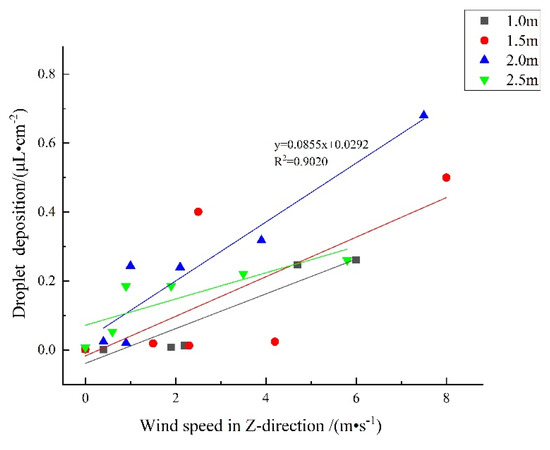
Figure 8.
Relationships between droplet deposition and the downwash wind field in Z-direction.
4. Conclusions
In this study, the DJI T16 plant protection UAV was used as the research object to conduct aerial spraying tests under four different flight height parameters, and the downwash wind field was measured by using a wireless wind speed sensor network measurement system for UAV. Combined with the droplet deposition of aerial spray, the distribution characteristics of the downwash wind field and the influence of the downwash wind field on droplet deposition were studied. The conclusions are shown as follows:
(1) There were obvious differences in the distribution of the downwash wind field for the plant protection UAV at different flight heights. As the flight height increased, the downwash wind field in X-direction and Z-direction showed a strong to weak trend, and the distribution ranged from large to small, while the downwash wind field in Y-direction showed an opposite trend.
(2) It was found that the downwash wind field in Y-direction and Z-direction both had a significant influence on the characteristics of droplet deposition. With the increase of flight height, the intensity of the downwash wind field in Y-direction and Z-direction gradually increased and decreased respectively, and the change of the downwash wind field led to the gradual decrease of droplet deposition and more uniformity in the effective spray area.
(3) In order to make full use of the downwash wind field, the appropriate flight height should be selected when UAV is used for aerial spray operations in the field. For the DJI T16 plant protection UAV in this test, the optimal flight height was 2.0 m, and the downwash wind field had a better promotion effect on droplet deposition.
Author Contributions
Y.L. and S.C. conceived the idea of the experiment; S.Q., Y.Z. (Yingjie Zhao), G.W. performed the field test; S.Q., X.D., and X.Q. analyzed the data; Y.L., S.Q., S.C., Y.Z. (Yu Zang), and J.W. wrote and revised the paper. All authors have read and agreed to the published version of the manuscript.
Funding
The study was funded by the National Natural Science Foundation of China (Grant No. 31901411), the Basic and Applied Basic Research Foundation of Guangdong Province (2020A1515110214), the science and technology planning project of Guangdong Province (2019B020208007), the Science and Technology Planning Project of Guangzhou (202103000090), the Key R&D projects in Hainan Province (ZDYF2020195), and the leading talents program of Guangdong Province (2016LJ06G689).
Institutional Review Board Statement
The study did not involve humans or animals.
Informed Consent Statement
The study did not involve humans.
Data Availability Statement
The data are not publicly available due to [Master’s degree thesis has not yet been completed and published].
Conflicts of Interest
The authors declare no conflict of interest.
References
- Lan, Y.; Chen, S.; Fritz, B.K. Current status and future trends of precision agricultural aviation technologies. Int. J. Agric. Biol. Eng. 2017, 10, 1–17. [Google Scholar]
- Wu, K. Development direction of crop pest control science and technology in China. J. Agric. 2018, 8, 35–38. [Google Scholar]
- Lan, Y.; Chen, S.; Deng, J.; Zhou, Z.; Ouyang, F. Development situation and problem analysis of plant protection unmanned aerial vehicle in China. Int. J. Agric. Biol. Eng. 2019, 10, 18–30. [Google Scholar]
- Zhou, Z.; Zang, Y.; Luo, X.; Lan, Y.; Xue, X. Technology innovation development strategy on agricultural. aviation industry for plant protection in China. Trans. Chin. Soc. Agric. Mach. 2013, 29, 1–10. (In Chinese) [Google Scholar]
- Wang, X. Research on Drift and Anti Drift Method of Pesticide Droplets; China Agricultural University: Beijing, China, 2017. [Google Scholar]
- Zhang, D.; Lan, Y.; Chen, L.; Wang, X.; Liang, D. Current status and future trends of agricultural aerial spraying technology in China. Trans. Chin. Soc. Agric. Mach. 2014, 45, 53–59. (In Chinese) [Google Scholar]
- Xue, X.; Lan, Y.; Sun, Z.; Chang, C.; Hoffmann, W.C. Develop an unmanned aerial vehicle based automatic aerial spraying system. Comput. Electron. Agric. 2016, 128, 58–66. [Google Scholar] [CrossRef]
- Zhou, Z.; Jiang, R.; Luo, X. Application analysis of liquid-level monitoring technology to plant protection UAV. Trans. Chin. Soc. Agric. Mach. 2017, 48, 47–55. (In Chinese) [Google Scholar]
- Yang, X.; Yan, H.; Xu, S.; Liu, Z. Current situation and development trend of equipment for crop protection. Trans. Chin. Soc. Agric. Mach. 2002, 33, 129–131. (In Chinese) [Google Scholar]
- Lan, Y.; Chen, S. Current status and trends of plant protection UAV and its spraying technology in China. Int. J. Precis. Agric. Aviat. 2018, 1, 1–9. [Google Scholar] [CrossRef]
- Yang, S.; Yang, X.; Mo, J. The application of unmanned aircraft systems to plant protection in China. Precis. Agric. 2018, 19, 278–292. [Google Scholar] [CrossRef]
- Chen, S.; Lan, Y.; Zhou, Z.; Ouyang, F.; Wang, G.; Huang, X.; Deng, X.; Cheng, S. Effect of droplet size parameters on droplet deposition and drift of aerial spraying by using plant protection UAV. Agronomy 2020, 10, 195. [Google Scholar] [CrossRef] [Green Version]
- Lan, Y.; Thomson, S.J.; Huang, Y.; Hoffmann, W.C.; Zhang, H. Current status and future directions of precision aerial application for site-specific crop management in the USA. Comput. Electron. Agric. 2010, 74, 34–38. [Google Scholar] [CrossRef] [Green Version]
- Qiu, B.; Wang, L.; Cai, D.; Wu, J.; Ding, G.; Guan, X. Effects of flight altitude and speed of unmanned helicopter on spray deposition uniform. Trans. Chin. Soc. Agric. Eng. 2013, 29, 25–32, (In Chinese with English abstract). [Google Scholar]
- Qin, W.; Xue, X.; Zhou, L.; Zhang, S.; Sun, Z.; Kong, W.; Wang, B. Effects of spraying parameters of unmanned aerial vehicle on droplets deposition distribution of maize canopies. Trans. Chin. Soc. Agric. Eng. 2014, 30, 50–56, (In Chinese with English abstract). [Google Scholar]
- Chen, S.; Lan, Y.; Li, J.; Zhou, Z.; Jin, J.; Liu, A. Effect of spray parameters of small unmanned helicopter om distribution regularity of droplet deposition in hybrid rice canopy. Trans. Chin. Soc. Agric. Eng. 2016, 32, 40–46, (In Chinese with English abstract). [Google Scholar]
- Chen, S.; Lan, Y.; Bradley, K.; Li, J.Y.; Liu, A.; Mao, Y. Effect of wind field below rotor on distribution of aerial spraying droplet deposition by using multi-rotor UAV. Trans. Chin. Soc. Agric. Mach. 2017, 48, 105–113. (In Chinese) [Google Scholar]
- Chen, S.; Lan, Y.; Li, J.; Zhou, Z.; Liu, A.; Mao, Y. Effect of wind field below rotor of unmanned helicopter on droplet deposition distribution of aerial spraying. Int. J. Agric. Biol. Eng. 2017, 10, 67–77. [Google Scholar]
- Zhang, S.; Xue, X.; Qin, W.; Sun, Z.; Ding, S.; Zhou, L. Simulation and experimental verification of aerial spraying drift on N-3 unmanned spraying helicopter. Trans. Chin. Soc. Agric. Eng. 2015, 31, 87–93, (In Chinese with English abstract). [Google Scholar]
- Yang, F.; Xue, X.; Zhang, L.; Sun, Z. Numerical simulation and experimental verification on downwash air flow of six-rotor agricultural unmanned aerial vehicle in hover. Int. J. Agric. Biol. Eng. 2017, 10, 41–53. [Google Scholar]
- Yang, F.; Xue, X.; Cai, C.; Sun, Z.; Zhou, Q. Numerical simulation and analysis on spray drift movement of multirotor plant protection unmanned aerial vehicle. Energies 2018, 11, 2399. [Google Scholar] [CrossRef] [Green Version]
- Li, J.; Zhou, Z.; Hu, L.; Zang, Y.; Xu, S.; Liu, A.; Luo, X.; Zhang, T. Optimization of Operation Parameters for Supplementary Pollination in Hybrid Rice Breeding Using Round Multi-Axis Multi-Rotor Electric Unmanned Helicopter. Trans. Chin. Soc. Agric. Eng. 2014, 30, 1–9. [Google Scholar]
- Li, J.; Zhou, Z.; Lan, Y.; Hu, L.; Zang, Y.; Liu, A.; Luo, X.; Zhang, T. Distribution of Canopy Wind Field Produced by Rotor Unmanned Aerial Vehicle Pollination Operation. Trans. Chin. Soc. Agric. Eng. 2015, 31, 77–86. [Google Scholar]
- Li, J.; Lan, Y.; Wang, J.; Chen, S.; Huang, C.; Liu, Q.; Liang, Q. Distribution Law of Rice Pollen in the Wind Field of Small UAV. Int. J. Agric. Biol. Eng. 2017, 10, 32–40. [Google Scholar]
- Hu, L.; Zhou, Z.; Luo, X. Design and Test of Wireless Sensor Network Measurement System for Wind Field of Unmanned Helicopter. Trans. Chin. Soc. Agric. Mach. 2014, 45, 221–226. [Google Scholar]
- Zhu, H.; Salyani, M.; Fox, R.D. A portable scanning system for evaluation of spray deposit distribution. Comput. Electron. Agric. 2011, 76, 38–43. [Google Scholar] [CrossRef]
- Chen, S.; Lan, Y.; Li, J.; Xu, X.; Wang, Z.; Peng, B. Evaluation and test of effective spraying width of aerial spraying on plant protection UAV. Trans. Chin. Soc. Agric. Mach. 2017, 33, 82–90. (In Chinese) [Google Scholar]
- Chen, S.; Lan, Y.; Li, J.; Zhou, Z.; Liu, A.; Xu, X. Comparison of the pesticide effects of aerial and artificial spray applications for rice. J. South China Agric. Univ. 2017, 38, 103–109. (In Chinese) [Google Scholar]
Publisher’s Note: MDPI stays neutral with regard to jurisdictional claims in published maps and institutional affiliations. |
© 2021 by the authors. Licensee MDPI, Basel, Switzerland. This article is an open access article distributed under the terms and conditions of the Creative Commons Attribution (CC BY) license (https://creativecommons.org/licenses/by/4.0/).